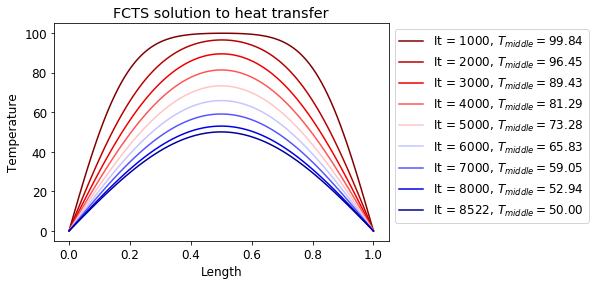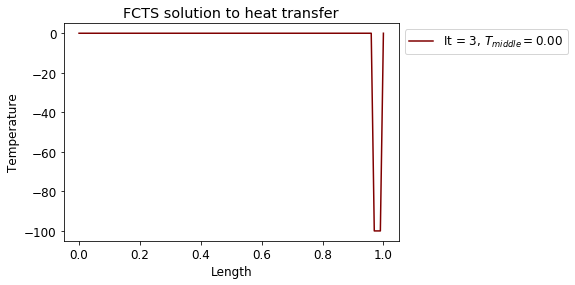FTCS scheme
Contents
FTCS scheme#
Forward Time Centred Space (FTCS) scheme is a method of solving heat equation (or in general parabolic PDEs). In this scheme, we approximate the spatial derivatives at the current time step and the time derivative between current and new time step:
The FCTS scheme is first order in time and up to 2nd order in space. It can be always rearranged into the following form:
Exercise
Derive an FTCS solution to the equation:
Forward difference in time:
Central difference in space:
Differentials combined in our equation: $\(\frac{u_{i}^{n+1}-u_{i}^{n}}{\Delta t}=\frac{u_{i+1}^{n}-2u_{i}^{n}+u_{i-1}^{n}}{\Delta x^2}.\)$
Rearrange the terms to get: $\(u_{i}^{n+1}=u_{i}^{n}+D\frac{\Delta t}{\Delta x^2}\Big(u_{i+1}^{n}-2u_{i}^{n}+u_{i-1}^{n}\Big).\)$
Numerical stability#
FCTS is an explicit scheme, where new time step value depends only on the current time step value. These schemes are quick to program and each time step runs quickly. A disadvantage to such schemes is that sometimes very small \(\Delta t\) are required for numerical stability.
Numerical stability is an issue in any explicit scheme as any effect can only move by a maximum of one spatial grid block in one time step. For example, a purely 1st order (convective) system FTCS is unconditionally unstable:
Lax-Friedrichs scheme#
For a purely convective equation a simple substitution can make it stable. For example, if we substitute \(u_{i}^{n}\) in the time derivative with \(\frac{u_{i+1}^{n}+u_{i-1}^{n}}{2}\), the we get a solution:
This solution is stable if CFL condition is met:
Why does Lax-Friedrichs method makes an FTCS scheme stable?
These two approximations are equivalent, if
The Lax-Friedrichs scheme introduces thus an artificial (numerical) diffusion. The FTCS scheme for a convective diffusion equation is stable if:
and
The conditions must be met at every point in the domain.
Heat transfer solution with FTCS method#
We will use an FTCS approximation of
to calculate the evolution of temperature in a rod of length 1. The initial temperature of the rod will be set at 100 but the ends of the rod will be kept constant at 0. The heat conductivity will be set at \(k=0.01\). The rod will be divided into 100 intervals (101 points).
At first we will need to discretise the problem. We will expand all terms with forward difference for time derivative and central difference for spatial derivative:
From the CFL condition, we know that for the solution to be stable, we need to ensure that:
import numpy as np
import matplotlib.pyplot as plt
plt.rcParams.update({'font.size': 12})
Set up variables and find maximum time step:
n = 101
T_old = np.zeros(n)
T_new = np.zeros(n)
for i in range(1,n-1):
T_old[i] = 100.
l = 1
dx = l/(n-1)
x = np.linspace(0,l,n)
print("dx = %.2f" % dx)
k = 0.01
dt_max = dx**2/(2*k)
dt = 0.2 * dt_max
print("Maximum dt = %.4f." % dt_max)
print("Used dt = %.4f." % dt)
dx = 0.01
Maximum dt = 0.0050.
Used dt = 0.0010.
Run the loop until temperature in the middle reaches 50:
count = 0
count2 = 0
colors = plt.cm.seismic_r(np.linspace(0,1,10))
while T_old[int(n/2)]>50.0:
for i in range(1,n-1):
T_new[i] = T_old[i]+dt*k*(T_old[i+1]-2*T_old[i]+T_old[i-1])/dx**2
T_old = T_new
count = count + 1
if count%1000==0:
plt.plot(x, T_new, color=colors[count2],
label="It = %g, $T_{middle}=%.2f$" % (count,T_old[int(n/2)]))
count2 = count2 + 1
plt.plot(x, T_new, color=colors[count2],
label="It = %g, $T_{middle}=%.2f$" % (count,T_old[int(n/2)]))
plt.title("FCTS solution to heat transfer")
plt.legend(bbox_to_anchor=[1,1])
plt.xlabel("Length")
plt.ylabel("Temperature")
plt.show()

The solution was obtained after 8,522 iterations.
What happens when \(\Delta t\) is larger than the one given by the CFL condition?
n = 101
T_old = np.zeros(n)
T_new = np.zeros(n)
for i in range(1,n-1):
T_old[i] = 100.
l = 1
dx = l/(n-1)
print("dx = %.2f" % dx)
k = 0.01
dt_max = dx**2/(2*k)
dt = 2 * dt_max
print("Maximum dt = %.4f." % dt_max)
print("Used dt = %.4f." % dt)
count = 0
count2 = 0
colors = plt.cm.seismic_r(np.linspace(0,1,10))
while T_old[int(n/2)]>50.0:
for i in range(1,n-1):
T_new[i] = T_old[i]+dt*k*(T_old[i+1]-2*T_old[i]+T_old[i-1])/dx**2
T_old = T_new
count = count + 1
if count%1000==0:
plt.plot(x, T_new, color=colors[count2],
label="It = %g, $T_{middle}=%.2f$" % (count,T_old[int(n/2)]))
count2 = count2 + 1
plt.plot(x, T_new, color=colors[count2],
label="It = %g, $T_{middle}=%.2f$" % (count,T_old[int(n/2)]))
plt.title("FCTS solution to heat transfer")
plt.legend(bbox_to_anchor=[1,1])
plt.xlabel("Length")
plt.ylabel("Temperature")
plt.show()
dx = 0.01
Maximum dt = 0.0050.
Used dt = 0.0100.

We can see that the solution went unstable immediately for a larger \(\Delta t\).

